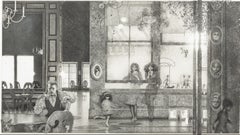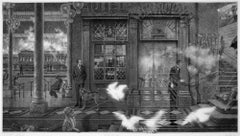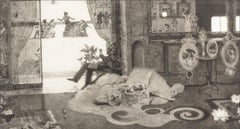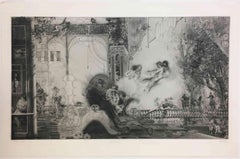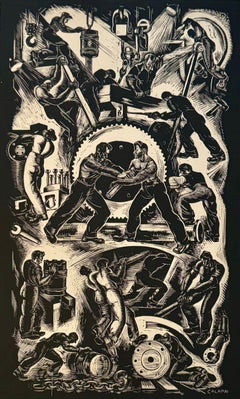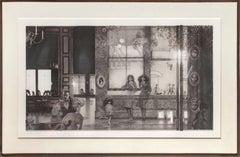Engraving Interior Prints
to
4
Overall Width
to
Overall Height
to
7
4
1
6
4
3
2
2
4
2
1
1
4
4
3
3
1
1
1
1
1
1
1
4
4
2
2
1
2
4
Style: Modern
Artist: Peter Milton
Medium: Engraving
Interiors I: Family Reunion — A penetrating scene with a hidden homage to Eadwea
By Peter Milton
Located in Middletown, NY
Interiors I: Family Reunion
1984
Resist ground etching and engraving on BFK Rives wove paper, 20 x 36 inches (501 x 913 mm), full margins. Signed, titled, dated and numbered 49/175 in pencil, lower margin. In excellent condition with minor mat tone. A luminous, rich, and well-inked impression of this haunting image, with astonishing detail and depth. Framed handsomely under museum grade glass with archival materials in a solid wood frame with silver finish. [Milton 107]
Intended to be a stand alone image in its inception, Family Reunion ended up spawning seven additional images, and became a sort of Primo Pensiero in the sprawling, masterpiece suite now known as Interiors. The suite took eight years to complete, and consists of works of varying format, psychological intensity, and subject matter. The thematic darkness in the eight images waxes and wanes, and Milton intentionally included several interlude works to lighten the tension he felt while composing several of the darker images. The first two in the series, Family Reunion, and Hotel Paradise Café, were meant to be companion pieces. The equilibrium of each composition is anchored on a central brooding figure; a man (perhaps based on a Thomas Eakins portrait of the American anthropologist Frank Hamilton...
Category
1980s American Modern Engraving Interior Prints
Materials
Engraving, Etching
Interiors VII: The Train from Munich
By Peter Milton
Located in Middletown, NY
Interiors VII: The Train from Munich
Robert E. Townsend, 1991.
Resist ground etching and engraving with hand refinement in charcoal, pencil, stabilo, and eraser on BFK Rives white wove paper, 20 x 36 inches (507 x 914 mm), full margins. Signed, titled, dated and numbered 51/175 by the artist in pencil, lower margin. A brilliant, inky impression with luminous light and gradient tones. In excellent condition with one extremely minor and superficial spot of light tan adhesive residue on the verso, unobtrusive and not visible on the recto, with no other visible defects. With the blind stamp of the printer, Robert E. Townsend in the lower left margin. An especially fine impression in superb condition. [Milton 113].
When asked about this work in particular, Milton expressed that his favorite images were his darkest images, in theme, mood, and in ink. Milton, who has said that his work is infused with a postmodern awareness of the past, has focused here in a deeply personal way on a segment of history that continues to haunt us all. The work, published in 1991, evokes one of the darkest periods of European history, the eroding and erasing of European culture under fascism, and the eventual total loss of humanity. The Train from Munich is an especially relevant and emotional work for Milton, who created the piece for his wife, Edith, who escaped Munich in 1939 as a child on the fabled Kinderstransport. The Kinderstransport was a desperate rescue effort on the part of the British government to save as many Jewish children as possible by railway before borders closed on the precipice of the Second World War. Children left their parents behind, and boarded the trains alone, leaving the impending doom of Nazi Germany, they arrived in Great Britain as refugees. More than 10,000 children escaped the holocaust via the Kinderstransport. In Train from Munich, the image itself holds an almost immeasurable amount of symbolism; each inch of the matrix is a successful effort to confront this history in a way that is poignant through a series of motifs. We see the Café disappearing into a ghostlike memory of the past, an allegory to the disintegration of culture, while through the windows we can see a rampant, snarling dog; a portrait of Hitler's shepherd, Blondi. Blondi isn't the only notable figure in the composition. Milton has pointed out that the fading figure of the doorman at the Hotel Metropole is modeled after the artist and intellectual Marcel Duchamp, and the face of the young girl peering...
Category
1990s American Modern Engraving Interior Prints
Materials
Charcoal, ABS, Engraving, Etching
Les Belles et La Bête I: The Rehearsal
By Peter Milton
Located in Middletown, NY
Resist ground etching and engraving on Rives heavyweight buff paper, 20 x 36 inches (508 x 914 mm), full margins. Signed, titled, dated and numbered 103/160 in pencil, lower margin. Minor mat tone. A rich and finely printed impression of this complex and iconic work by Milton. Framed handsomely under Plexiglas with archival materials in a solid wood frame with silver finish.
[Milton 98].
Milton states that in the evolution of his body of graphic work he found himself at point that necessitated the exertion of nerve in his subject matter. He found it imperative for growth to explore whether his compositions had previously been too polite, and through this process he experienced a great burst of artistic and psychic liberation. Milton refers to this awakening as a sort of adolescence, which he felt demanded a natural examination of mysteries of sexual awakening. Les Belles et La Bête...
Category
1970s American Modern Engraving Interior Prints
Materials
Archival Paper, Engraving, Etching
Les Belles et la Bête: Before the Hunt
By Peter Milton
Located in Middletown, NY
Resist ground etching and engraving on cream wove paper, 22 x 39 inches (558 x 990 mm), full margins. Signed, titled, dated, and numbered 27/160 in pencil, lower margin. With the blindstamp of the printer, Robert E. Townsend, in the lower left margin. A beautiful, richly inked impression of this highly detailed, large image. In very good condition with minor mat tone, extremely minor scattered light surface soiling, and one pin-point sized dot of brown discoloration on the lower left margin, recto, well outside of image area.
[Milton 99].
Milton states that there is a metaphorical evolution at the root of his body of graphic work, and with Les Belles et la Bête, Before the Hunt, he found himself at a crossroads that he viewed as a sort of artistic adolescence, which he felt demanded a natural examination of mysteries of sexual awakening. The image is brimming with fantastical images and metaphors for the confrontation of sexual exploration; a Freudian analyst appears in the left of the image, scattered tableaus of paired figures...
Category
1970s American Modern Engraving Interior Prints
Materials
Archival Paper, Engraving, Etching
Related Items
William P. Hicks, Circus
Located in New York, NY
William P. Hicks has drawn everything about the circus that will fit in the plate. The main figure is an aerial act with a woman balancing on rope held by a figure on the floor. Ther...
Category
1930s American Modern Engraving Interior Prints
Materials
Etching
"Labor in a Diesel Plant" Machine Age American Scene Industrial Mid 20th Century
Located in New York, NY
"Labor in a Diesel Plant" Machine Age American Scene Industrial Mid 20th Century
Letterio Calapai (American 1902-1993)
''Labor in A Diesel Plant''
Wood engraving, 1940
17 x 10 1/2...
Category
1940s American Modern Engraving Interior Prints
Materials
Lithograph
$6,900
H 23 in W 16 in D 2 in
New York Map of Days, Illustration New York Map, Blue Art, NYC, Geography print
Located in Deddington, GB
New York Map of Days is a limited edition etching by Mychael Barratt. The illustrative style of this piece brings New York, it’s landmarks and endless stor...
Category
2010s Contemporary Engraving Interior Prints
Materials
Paper, Etching
Mychael BarrattNew York Map of Days, Illustration New York Map, Blue Art, NYC, Geography print, 2019
$1,268
H 29.14 in W 43.19 in D 0.04 in
Mychael Barratt, London Bestiary, Animal Art, Illustrated Cityscape, Happy Art
Located in Deddington, GB
London Bestiary by Mychael Barratt
Limited Edition Etching: Edition of 100
Image Size: H 66m x W 99.7cm
Complete size of Sheet: H 76.9cm x W 112.1cm x D 0.1cm
Signed and titled
Sold ...
Category
2010s Contemporary Engraving Interior Prints
Materials
Paper, Screen
$1,268
H 30.28 in W 44.14 in D 0.04 in
"Balcony" 1938 WPA Print Mid 20th Century American Broadway Theatre Modernism
By Leon Bibel
Located in New York, NY
"Balcony" 1938 WPA Print Mid 20th Century American Broadway Theatre Modernism.
Silk screen on paper, 15” x 20". Numbered 15/20 lower left. Pencil si...
Category
1930s American Modern Engraving Interior Prints
Materials
Paper, Screen
Adolf Dehn, The Big-Hearted Girls (The Last Veil), 1932, burlesque lithograph
By Adolf Dehn
Located in New York, NY
Adolf Dehn's, lithograph about burlesque, The Big Hearted Girls #2 (also known as The Last Veil), is filled with dancing girls and fabulous costumes. That central figure is a marvel!...
Category
1940s American Modern Engraving Interior Prints
Materials
Lithograph
Bernard Sanders, Head of Girl
Located in New York, NY
For a print that's nearly one hundred years old it feels very contemporary.
Signed in pencil; titled in lower margin in pencil.
Category
Early 20th Century American Modern Engraving Interior Prints
Materials
Drypoint
Yayoi Kusama's Garden, Celebrity Garden Art, Yayoi Kusama Style ContemporaryArt
Located in Deddington, GB
Limited edition print of a woman surrounded by sunflowers.
Buy Mychael Barratt printmaker works with Wychwood Art gallery online. Mychael Barratt was born in Toronto, Canada, however...
Category
2010s Contemporary Engraving Interior Prints
Materials
Paper, Screen
Mychael BarrattYayoi Kusama's Garden, Celebrity Garden Art, Yayoi Kusama Style ContemporaryArt, 2023
$881
H 25.6 in W 25.6 in D 0.04 in
New Orleans Go Greyhound original vintage travel poster
Located in Spokane, WA
Orignal NEW ORLEANS GREYHOUND vintage travel poster; larger format size. Excellent condition that has acid-free archival linen backing; ready to frame.
This image is from the old French Quarter section of New Orleans. It features two women entering into the courtyard and in the background, the old stairs leading to the upstairs area. A bright and colorful image that would compliment any room or office. A great New Orleans vintage poster...
Category
1960s American Modern Engraving Interior Prints
Materials
Offset
$580 Sale Price
20% Off
H 38.25 in W 28 in D 0.05 in
Four Koa Wood Framed 18th C. Engravings from Captain Cook's 3rd Voyage Journal
By John Webber
Located in Alamo, CA
A grouping of four framed engravings of Hawaii, Tahiti, Tonga and Vancouver Island from the atlas of the official British Admiralty sanctioned journal of Captain Cook's 3rd Voyage entitled "A Voyage to the Pacific Ocean Undertaken by the Command of His Majesty, for Making Discoveries in the Northern Hemisphere", published upon completion of the voyage in London in 1784 by Strahan & Cadell. These engravings were made from drawings by John Webber (1752-1793), who was the artist on Captain James Cook's 3rd and final voyage of discovery. The set of engravings includes: "A Canoe of the Sandwich Islands, the Rowers Masked", Plate 65 in the atlas; "A Dance in Otaheite" (Tahiti), Plate 28; "King of the Friendly Islands" (Tonga), plate 20; "Inside of a House in Nootka Sound" (Canada), plate 42.
These engravings are professionally framed in Koa wood, the same wood as was used to make the canoes of the ancient Hawaiians. Koa wood is legendary in Hawaii. Not only is this amazing wood native to Hawaii, but it is known for the deep rich colors and varied grain pattern. Koa has an honored heritage in Hawaii and is highly revered and sacred. The word “koa” means “warrior” in Hawaiian. The warriors of King Kamehameha the Great, created canoes and weapons from a wood plentiful on the Big Island of Hawaii. This wood became synonymous with the warriors themselves, and it became known as koa.
These four engravings would make a wonderful grouping for a display of 2, 3 or 4 prints. They may be purchased separately or in groups on 1stDibs. Their listing Reference #'s are: LU117324682432, LU117324682022, LU117324684052 and LU117324684062. A discount is available for a grouping depending on the number of items included.
Hawaii was discovered by Captain Cook (1728-1779) during this voyage. Hawaii was originally called The Sandwich Islands in honor of The Earl of Sandwich...
Category
1780s Other Art Style Engraving Interior Prints
Materials
Engraving
$7,660 Sale Price
20% Off
H 20.75 in W 26.75 in D 0.88 in
Dandelion Clocks, Landscape Print, Rural Countryside Art, Tractor Art, Harvest
By Rob Barnes
Located in Deddington, GB
There is a time of year when dandelions abound in the local fields. I often see a red tractor ploughing late crops and this view is inspired by a fine day for dandelions. Ploughings give a sense of direction in cantrast with the dandelion clocks.
Rob Barnes, artist, is available for sale online and in our art gallery at Wychwood Art. Rob Barnes studied painting and printmaking at Hull College of Art and London University in the early 1960s. He taught etching, screen-printing, lino and related surface printmaking at Keswick Hall College in Norfolk. He later moved to the University of East Anglia, Norwich where he continued teaching in the School of Education until 2006. Presently he divides his time between printmaking and his other passion, playing the violin in local orchestras and for choral performances. In 2017 he began making a small number of sterling silver jewellery pieces following a course at West Dean, Sussex. His artwork follows themes, such as light on water, or shadows in the landscape. Linocuts are hand-printed on an Albion press...
Category
2010s Contemporary Engraving Interior Prints
Materials
Paper, Linocut
$247
H 19.3 in W 24.02 in D 0.04 in
Le Seuil (The Threshold)
Located in New Orleans, LA
"Le Seuil" (The Threshold) is an image printed in 2006. This impression is Roman numeral X of XX. It is titled, dated, numbered and signed by the artist.
Judith Rothchild, printma...
Category
21st Century and Contemporary Contemporary Engraving Interior Prints
Materials
Mezzotint
Previously Available Items
Interiors I: Family Reunion
By Peter Milton
Located in Long Island City, NY
Artist: Peter Milton, American (1930 - )
Title: Interiors I : Family Reunion
Year: 1984
Medium: Etching and engraving, signed, numbered, dated, and titl...
Category
1990s American Modern Engraving Interior Prints
Materials
Etching, Engraving
Engraving interior prints for sale on 1stDibs.
Find a wide variety of authentic Engraving interior prints available on 1stDibs. While artists have worked in this medium across a range of time periods, art made with this material during the 21st Century is especially popular. There are many well-known artists whose body of work includes ceramic sculptures. Popular artists on 1stDibs associated with pieces like this include Carol Wax, Edmund Blampied, Peter Milton, and Laurent Schkolnyk. Frequently made by artists working in the Modern, Contemporary, all of these pieces for sale are unique and many will draw the attention of guests in your home. Not every interior allows for large Engraving interior prints, so small editions measuring 2.01 inches across are also available Prices for interior prints made by famous or emerging artists can differ depending on medium, time period and other attributes. On 1stDibs, the price for these items starts at $66 and tops out at $59,000, while the average work can sell for $560.
